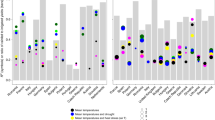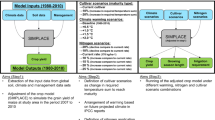Abstract
Climate is a major driver of agricultural production potentials. To make the best use of these potentials, agricultural management should be adjusted to local climatic conditions. As these conditions change over time, understanding climatic limitations and their trends in time and space is essential for the planning of suitable adaptation measures. In this study, we provide a detailed spatio-temporal analysis of climatic yield potentials for grain maize and winter wheat in Switzerland. We find that current climatic suitability for grain maize is mostly limited by sub-optimal temperatures, radiation and water scarcity, while climatic suitability for winter wheat is mostly limited through excess water, insufficient radiation, as well as frost and heat stress. Over the investigated period from 1983 to 2010, few regional trends in climate suitability were identified for the two crops, indicating that grain maize has benefitted slightly from increasing growth temperatures with recent warming (0.5 °C/decade), while winter wheat suitability decreased slightly due to suboptimal radiation/temperature ratios with warming. Despite only small trends in climate suitabilities, which are restricted to particular regions, future climatic changes could lead to more pronounced shifts. The tendencies of climate limitations identified in this study are mostly consistent with findings from other studies, and it can thus be anticipated that maize may continue to benefit from increasing temperatures on the short term, but may also be increasingly limited by water scarcity as summer precipitation decreases. For winter wheat, the relevance of heat stress is likely to increase with increasing temperatures. These results may help to support short-term adaptation planning. However, more detailed analyses of climate projections will be necessary to investigate “critical transitions” and provide more specific information to support long-term climate change adaptation planning (e.g. for irrigation and breeding programmes).







Similar content being viewed by others
References
Acevedo E, Silva P, Silva H (2002) Wheat growth and physiology. In: Curtis BC, Rajaram S, Macpherson HG (eds) Bread wheat—improvement and production. FAO Plant Production and Protection Series. FAO, Rome
Ahmed F et al (2013) Waterlogging tolerance of crops: breeding, mechanism of tolerance, molecular approaches, and future prospects. BioMed Research International, 2013 (Article ID 963525), pp 1–10
Barnosky AD et al (2012) Approaching a state shift in Earth’s biosphere. Nature 486(7401):52–58
Brisson N et al (2010) Why are wheat yields stagnating in Europe? A comprehensive data analysis for France. Field Crops Res 119(1):201–212
Ceppi P, Scherrer SC, Fischer AM, Appenzeller C (2012) Revisiting Swiss temperature trends 1959–2008. Int J Climatol 32:203–213
Chapman SC, Chakraborty S, Dreccer MF, Howden SM (2012) Plant adaptation to climate change—opportunities and priorities in breeding. Crop Pasture Sci 63(3):251–268
Dong JW, Liu JY, Tao FL, Xu XL, Wang JB (2009) Spatio-temporal changes in annual accumulated temperature in China and the effects on cropping systems, 1980s to 2000. Clim Res 40(1):37–48
FAO (1993) Guidelines for land-use planning, Food and Agriculture Organization of the United Nations, Rome
FAO (2002) BREAD WHEAT—improvement and production FAO plant production and protection series, 30. Food and Agriculture Organization of the United Nations, Rome
FAT (2003) Ergebnisse der Zentralen Auswertung von Buchhaltungsdaten. In: Agroscope FAT Tänikon (Editor), Schweiz
Fischer RA (1985) Number of kernels in wheat crops and the influence of solar radiation and temperature. J Agric Sci 105:447–461
Fischer RA, Maurer R (1976) Crop temperature modification and yield potential in a dwarf spring wheat. Crop Sci 16(6):855–859
Frei C, Schär C (1998) A precipitation climatology of the Alps from high-resolution rain-gauge observations. Int J Climatol 18(8):873–900
Frei C, Schöll R, Fukutome S, Schmidli J, Vidale PL (2006) Future change of precipitation extremes in Europe: intercomparison of scenarios from regional climate models. J Geophys Res Atmos 111(D6):1–22
Fuhrer J (2011) Abschätzungen zum Wasserbedarf und zur Wasserverfügbarkeit in der Schweizer Landwirtschaft unter heutigen und zukünftigen Klimabedingungen, Bern
Gate P (1995) Écophysiologie du blé. Technique & Documentation—Lavoisier, Paris
Hawkins E et al (2013) Increasing influence of heat stress on French maize yields from the 1960s to the 2030s. Glob Change Biol 19:937–947
Hiltbrunner J, Buchmann U, Baux A, Collaud J-F, Bertossa M (2013) Liste der empfohlenen Maissorten für die Ernte 2013. Agrarforschung Schweiz 4(2):1–6
Holzkämper A, Calanca P, Fuhrer J (2013) Identifying climatic limitations to grain maize yield potentials using a suitability evaluation approach. Agric For Meteorol 168:149–159
Jayathilaka PMS, Soni P, Perret S, Jayasuriya HPW, Salokhe V (2012) Spatial assessment of climate change effects on crop suitability for major plantation crops in Sri Lanka. Reg Environ Change 12(1):55–68
Jeanneret F, Vautier P (1977) Kartierung der Klimaeignung für die Landwirtschaft in der Schweiz - Levé cartographique des aptitudes climatique pour l’agriculture en Suisse (Climate suitability mapping for agriculture in Switzerland), Jahrbuch der Geographischen Gesellschaft von Bern Beiheft (4), Bern, 108 p
Lang R, Müller A (1999) CropData—Kennwerte und ökologische Ansprüche der Ackerkulturen (CD-ROM). Uismedia, Freising
Liu Y, Wang E, Yang X, Wang J (2010) Contributions of climatic and crop varietal changes to crop production in the North China Plain, since 1980s. Glob Change Biol 16(8):2287–2299
Lobell DB, Field CB (2007) Global scale climate—crop yield relationships and the impacts of recent warming. Environ Res Lett 2(1):1–7
Lobell DB, Schlenker W, Costa-Roberts J (2011) Climate trends and global crop production since 1980. Science 333(6042):616–620
Ludwig F, Asseng S (2010) Potential benefits of early vigor and changes in phenology in wheat to adapt to warmer and drier climates. Agric Syst 103(3):127–136
Mackay I, Horwell A, Garner J, White J, McKee J, Philpott J (2011) Reanalyses of the historical series of UK variety trials to quantify the contributions of genetic and environmental factors to trends and variability in yield over time. Theor Appl Genet 122(1):225–238
Mann HB (1945) Nonparametric tests against trend. Econometrica 13:245–259
MeteoSwiss (2012a) Documentation of MeteoSwiss grid-data products: daily mean, minimum and maximum temperature: TabsD, TminD, TmaxD. Available from www.meteoschweiz.ch
MeteoSwiss (2012b) Klimareport 2011
MeteoSwiss (2013) Climate trends from stations. http://www.meteoschweiz.admin.ch/web/en/climate/climate_today/trends_from_stations.html. Access date: 8 March 2013
Nalley LL, Barkley AP, Sayre K (2009) Photothermal quotient specifications to improve wheat cultivar yield component models. Agron J 101(3):556–563
Nix HA (1976) Climate and crop productivity in Australia. In: Yoshida S (ed) Climate and rice. International Rice Research Institute, Los Baños, pp 495–507
Olesen JE et al (2007) Uncertainties in projected impacts of climate change on European agriculture and terrestrial ecosystems based on scenarios from regional climate models. Clim Change 81:123–143
Olesen JE et al (2011) Impacts and adaptation of European crop production systems to climate change. Eur J Agron 34(2):96–112
Peltonen-Sainio P et al (2010) Coincidence of variation in yield and climate in Europe. Agric Ecosyst Environ 139(4):483–489
Posselt R, Müller R, Trentmann J, Stöckli R (2012) Remote sensing of solar surface radiation for climate monitoring—the CM-SAF retrieval in international comparison. Remote Sens Environ 118:186–198
Priestley CHB, Taylor RJ (1972) On the assessment of surface heat flux and evaporation using large-scale parameters. Mon Weather Rev 100(2):81–92
Primault B (1972) Ausreifwahrscheinlichkeiten von Körnermais bis 15. Oktober (Probabilities of maturation for grain maize by October 15). In: Eidgenössischen Forschungsanstalt für Betriebswirtschaft und Landtechnik (Editor), Agrometeorologische Blätter der Eidgenössischen Forschungsanstalt für Betriebswirtschaft und Landtechnik Tänikon, Tänikon
R Development Core Team (2010) R: a language and environment for statistical computing. In: R Foundation for Statistical Computing (Editor), Vienna, Austria
Sacks WJ, Kucharik CJ (2011) Crop management and phenology trends in the U.S. Corn Belt: impacts on yields, evapotranspiration and energy balance. Agric For Meteorol 151(7):882–894
Schreiber KF, Kuhn N, Hug C, Haeberli R, Schreiber C (1977) Wärmegliederung der Schweiz = Niveaux thermiques de la Suisse (Thermal classification for Switzerland). In: Eidg. Justiz-und Polizeidepartement. Der Delegierte für Raumplanung (BRP) (Editor), Grundlagen für die Raumplanung, Bern, pp. Text & 4 maps
Semenov MA, Shewry PR (2011) Modelling predicts that heat stress, not drought, will increase vulnerability of wheat in Europe. Nature Scientific Reports, 1
Siebert S, Ewert F (2012) Spatio-temporal patterns of phenological development in Germany in relation to temperature and day length. Agric For Meteorol 152:44–57
Stöckli R (2013) The HelioMont surface solar radiation processing, MeteoSwiss
Tao F, Zhang S, Zhang Z (2012) Spatiotemporal changes of wheat phenology in China under the effects of temperature, day length and cultivar thermal characteristics. Eur J Agron 43:201–212
Willmott CJ (1981) On the validation of models. Phys Geog 2:184–194
Acknowledgments
We would like to thank the Federal Office of Meteorology and Climatology MeteoSwiss for providing daily gridded meteorological data used in this study, Andreas Roesch from Agroscope Tänikon for providing the yield data for the data-based refinement of factor suitability functions, Pierluigi Calanca from Agroscope Reckenholz for providing valuable comments on the manuscript and Alice Baux from Agroscope Changins for providing expert information on crop requirements and comments on the manuscript. The work contributes to the National Research Program NCCR Climate.
Author information
Authors and Affiliations
Corresponding author
Additional information
Editor: Wolfgang Cramer.
Appendix
Appendix
Factor suitability functions for winter wheat identified in 50 GA runs (black lines; orange lines show average functions) within the pre-defined knowledge-based bounds (grey areas) [P = precipitation, ET0 = reference evapotranspiration, T min = minimum temperature, T max = maximum temperature, PTQ = photothermal quotient calculated as average daily solar radiation (MJ/m2) divided by average daily mean temperature (°C); Fig. 8].
Factor suitability functions for winter wheat identified in 50 GA runs (black lines; orange lines show average functions) within the predefined knowledge-based bounds (grey areas) (P precipitation, ET 0 reference evapotranspiration, T min minimum temperature, T max maximum temperature, PTQ photothermal quotient calculated as average daily solar radiation [MJ/m2] divided by average daily mean temperature [°C]) (colour figure online)
Rights and permissions
About this article
Cite this article
Holzkämper, A., Fossati, D., Hiltbrunner, J. et al. Spatial and temporal trends in agro-climatic limitations to production potentials for grain maize and winter wheat in Switzerland. Reg Environ Change 15, 109–122 (2015). https://doi.org/10.1007/s10113-014-0627-7
Received:
Accepted:
Published:
Issue Date:
DOI: https://doi.org/10.1007/s10113-014-0627-7





